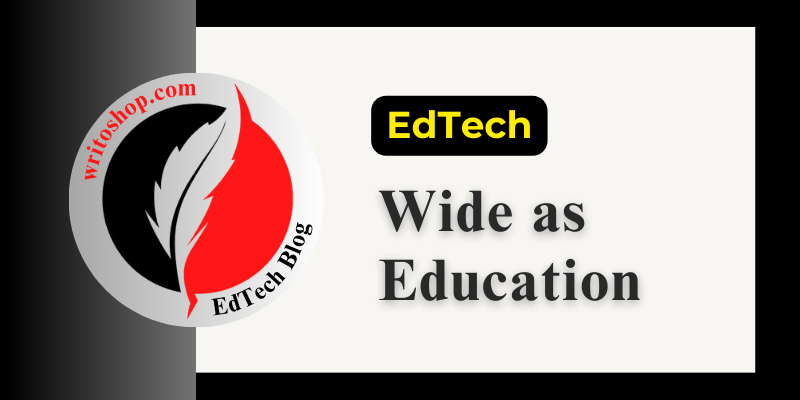
Education is vast—it touches every age group, subject, culture, and learning style.
Similarly, educational technology (EdTech) isn’t limited to one tool or platform. It evolves alongside education itself, providing solutions from preschool to postgraduate learning and beyond.
This is why experts often say that “educational technology is as wide as education”—because it serves every aspect and stakeholder in the learning ecosystem. Let’s explore how and why this statement holds true.
What Does “As Wide As Education” Mean?
To say that educational technology is “as wide as education” means that its scope, application, and impact cover every level and type of educational process:
- Formal and informal learning
- All age groups—from children to adults
- All formats—classroom, hybrid, and online
- All disciplines—from science and math to art and vocational training
Educational technology supports, enhances, and transforms learning experiences in nearly every educational setting imaginable.
EdTech Spans All Education Levels
- Early Childhood – Interactive games, audio-visual tools, and educational apps support playful learning, language development, and cognitive skills.
- Primary & Secondary School – Smartboards, tablets, educational videos, and gamified content make subjects like math, science, and history more engaging and accessible.
- Higher Education – LMS platforms (like Moodle, Blackboard), online assessments, and research databases streamline university-level learning, testing, and communication.
- Professional & Adult Learning – Online certifications, webinars, and e-learning platforms like Coursera or Udemy help professionals upskill at their own pace.
EdTech Covers All Subjects and Skills
Educational technology is not just for STEM subjects. It enhances:
- Languages – Through speech recognition, grammar apps, and virtual conversation partners.
- Arts – Via digital design tools, virtual galleries, and music composition apps.
- Vocational Training – Through simulations, AR/VR environments, and online workshops.
- Soft Skills – Like communication, leadership, and critical thinking via collaborative tools and scenario-based learning.
EdTech Supports Diverse Teaching and Learning Methods
- Blended Learning: Combining in-person teaching with digital tools.
- Flipped Classrooms: Students learn through videos at home and apply knowledge in class.
- Collaborative Learning: Using tech tools like Google Docs or Padlet for group work.
- Self-Paced Learning: Letting students access content anytime, anywhere.
- Whether teaching visually, verbally, or through interaction, EdTech adapts to meet different learning styles and paces.
EdTech Serves Teachers, Students, and Institutions Alike
- Teachers get tools for content creation, virtual classrooms, and real-time assessment.
- Students get personalized learning paths and engaging, interactive content.
- Institutions benefit from data analytics, automation, and broader student reach.
- This widespread use makes EdTech essential for every stakeholder in education.
Technology in Non-Traditional Education
Educational technology also plays a key role in non-traditional education, such as:
- Home Schooling – Parents and tutors use online curricula, learning games, and digital tracking tools.
- Special Education – Assistive technologies support students with disabilities through screen readers, speech-to-text tools, and tailored learning modules.
- Rural & Underserved Communities – EdTech helps bridge gaps in quality education through mobile learning and low-bandwidth platforms.
EdTech is Evolving with Education
As education evolves, so does EdTech. Key emerging areas include:
- AI-powered tutors – Offering personalized feedback and study plans.
- Augmented Reality (AR) – Bringing abstract concepts to life (e.g., anatomy, astronomy).
- Virtual Reality (VR) – Simulating real-world experiences for skill-based learning.
- Gamification – Turning lessons into engaging challenges and rewards.
The future of education is tightly linked to how EdTech continues to innovate and respond to learners’ changing needs.
Global Reach and Accessibility
Educational technology breaks geographic barriers:
- A student in a remote village can attend Harvard’s free online courses.
- Language translation and subtitles make global education more accessible.
- Cloud storage and mobile learning ensure continuous access, even during crises like the COVID-19 pandemic.
This global accessibility highlights how EdTech has a borderless impact, much like education itself.
Conclusion
Education touches every part of life—from learning the alphabet to mastering artificial intelligence. Because of this, educational technology must be equally expansive.
It adapts, scales, and evolves to support learners across all walks of life.
So yes, educational technology truly is as wide as education. It’s not just a tool—it’s a growing ecosystem that mirrors and amplifies the vastness of human learning.
